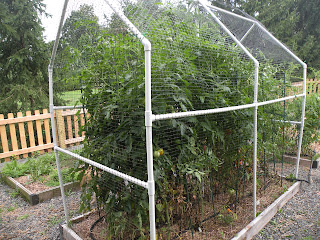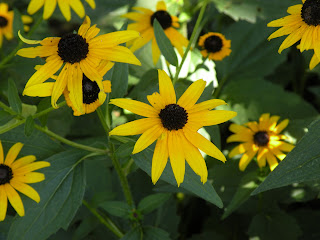So, this time last year I listed my New Year's Resolution. Let's see how well I did:
1) Don't work as many hours - make it home for dinner with my husband most nights a week.
Score 1 point! I will admit there were times I worked many late nights, but I did make it home in time for dinner MOST nights a week. YAY!
2) Major promotion at work.
Score 1 point! By June I was promoted to Preconstruction Manager and currently manage all the estimating, budgeting, and purchasing functions of our company and have 4 direct reports! Awesome!
3) Cook all week meals at home.
Score 1/2 a point. We did OK at this - but we have some room for improvement.
4) Buy less prepared food.
Score 1 point! We did pretty well at this! And we are going to take it one step further in 2013!
5) Take back the chickens.
Score 0 points. I failed at this resolution. Luckily - my husband is still the best and loves those little chickens and makes sure they don't starve! In my defense, I decided to go back to school to get my Master's degree, which was definitely more time consuming than anticipated!
6) Clean up, clean out, and get rid of the JUNK in our house.
Score 1 point! We had a yard sale this spring and then immediately called a donation service and had them come pick up everything that was left. Of course, as the year went on we have identified more things that we never use and are planning on getting rid of those in 2013!
7) Not bring more JUNK into the house.
Score 1 point! I did really well at this. Don't get me wrong, I spent more money in 2012 than I should have, but it was on things like - a new fence, soil and stone, plants, canning supplies (amazing how many jars we went through!), homebrew supplies, etc. All that work definitely relieved the stress way better than retail therapy anyway!!
So, final score: 5.5/7 = 78.5% Hmm... C+ I can definitely do better than that in 2013.
This blog is about a suburban couple trying to live a more sustainable life. It started with a few pots of tomatoes in the front yard and has grown to 5 chickens, a huge vegetable garden, berry patches, a fruit orchard, canning, beer brewing, and more!
Friday, December 28, 2012
Wednesday, December 26, 2012
Sunday, December 2, 2012
Hot Sauce Completed
So after letting the pepper mash ferment for about two months, I decided to bottle it up. Back when it started fermenting, some small spots of white mold started to form on the surface of the pepper mash that was above the brine. So I topped off the jug with more water so that it was completely filled with pepper mash and brine. The first 2 weeks of fermentation was fairly aggressive, as it forced all the pepper mash to the top of the jug, and pushed some up through the airlock, which made a mess.
You can see the pepper mash changed from a greenish color to more brownish, and even after the fermentation slowed down, all the mash was still forced up against the top of the jug:
You can see the pepper mash changed from a greenish color to more brownish, and even after the fermentation slowed down, all the mash was still forced up against the top of the jug:
It definitely had a sourish strong aroma, a little funky. Upon tasting the mash, two things were clear. One, that I used way too much salt (6 oz). Two, that either the Tabasco peppers or Fish peppers were VERY hot. I hoped that most of the salt was in the brine, so I strained the liquid from the mash.
That definitely helped. But the pepper mash was much too hot (and too thick) to use as straight hot sauce for "everyday" uses like on eggs or tacos. So I thawed a container of tomato puree that we had frozen from the garden. Since the tomato puree was just blended whole tomatoes that were cooked down, it was very thin and could thin out the pepper mash and cut some of the heat. I made three variations, X, XX, and XXX, increasing in heat. Most of the sauce was made as the milder X recipe which has a nice balance of flavor and slow burn heat, with just few bottles of the others. The variations:
X - 1 part pepper mash to 4 parts tomato puree, with rice vinegar and brown sugar to taste
XX- Equal parts pepper mash and tomato puree, again with rice vinegar and brown sugar
XXX- Pepper mash, with some rice vinegar and water to thin it out a bit.
For reference, the mix of varieties of peppers was:
1/2 lb Red Zavory
1/2 lb Fish
1/2 lb Tabasco
1/2 lb Jalapeno
2 lb Salsa
2 lb Poblano
1.5 lb Sweet Bell
Hard Cider Experiment
So Sheila has become a fan of some hard ciders, especially some of the "craft brewed" ones that she's tried when we're at beer bars. So I put together some experimental batches to see if I can successfully homebrew some. For two of the batches, I used some very tasty fresh cider from a local orchard that they were selling at Keystone Homebrew Store. The plan is let these age until next fall, and see what the results are.
Batch #1:
1 gallon Solebury Orchard cider
1 tsp yeast nutrient
Wyeast 4766 cider yeast
Batch #2:
1 gallon Solebury Orchard cider
1 tsp yeast nutrient
Danstar Nottingham Ale Yeast
Batch #3:
1 gallon Nature's Choice organic apple juice (no preservatives)
8 oz corn sugar
1 tsp yeast nutrient
Wyeast 4766 cider yeast
Batch #1:
1 gallon Solebury Orchard cider
1 tsp yeast nutrient
Wyeast 4766 cider yeast
Batch #2:
1 gallon Solebury Orchard cider
1 tsp yeast nutrient
Danstar Nottingham Ale Yeast
Batch #3:
1 gallon Nature's Choice organic apple juice (no preservatives)
8 oz corn sugar
1 tsp yeast nutrient
Wyeast 4766 cider yeast
Black IPA with homegrown hops
So the Black IPA that I made using the staggered harvest of Cascade and Nugget hops turned out pretty good. The beer has a big hop aroma from the dry hopping, and the taste is nice balance of slightly roasted grains and pungent hop flavors - citrus, pine, grassy, earthy. Nice body too.
Recipe was:
6.6 lb Pale Liquid Malt Extract
2.0 lb Light Dry Malt Extract @30min
.75 lb Carafa III Special Malt (steeped)
.75 lb Crystal 60 Malt (steeped)
1.75 oz Chinook @60min
1.5 oz Centennial @60min
1.0 oz Nugget @30min
2 to 3 oz (equivalent) of homegrown wet Nugget and Cascade @ 5min
Wyeast 1056 American Ale yeast
Dry Hop of 3 oz of homegrown dried Nugget and Cascade in secondary for 1 week
O.G. 1.070
F.G. 1.020
abv ~6.5%
Recipe was:
6.6 lb Pale Liquid Malt Extract
2.0 lb Light Dry Malt Extract @30min
.75 lb Carafa III Special Malt (steeped)
.75 lb Crystal 60 Malt (steeped)
1.75 oz Chinook @60min
1.5 oz Centennial @60min
1.0 oz Nugget @30min
2 to 3 oz (equivalent) of homegrown wet Nugget and Cascade @ 5min
Wyeast 1056 American Ale yeast
Dry Hop of 3 oz of homegrown dried Nugget and Cascade in secondary for 1 week
O.G. 1.070
F.G. 1.020
abv ~6.5%
Friday, November 16, 2012
Soybeans, Scarlet Runner Beans, Snap Peas
After our Scarlet Runner Bean plants didn't produce any bean pods in the heat of the summer, they did grow pods as the weather cooled, and we were able to pick some pods that were developed, and they were huge!
The beans are funky, from pink to purple. It turns out that only the purple ones dried correctly, so the pink ones weren't fully developed yet.
Dried snap pea pods that were left of the plant were harvested for seeds. Look like we have way too many. Oh well.
The soybeans did very well.
We blanched and froze them.
Pumpkins and Gourds
The pumpkin vines started great, but then we think they got bacteria wilt or something else nasty from the stupid squash bugs and cucumber beatles. We sprayed the bugs with horticultural oil, but there were too many of them. Next year we'll have be better with our organic bug control.

Hot Pepper Jelly and Fermented Hot Sauce
We canned a batch of hot pepper jelly from some of the Red Zavory and Jalepeno peppers.
Then for the last batch of radom peppers, I decided to try to make some fermented hot sauce.
The peppers were stemmed, then pureed, then salt added, and some whey off the top of some yogurt, to give it some "good" bacteria to ferment.Similar to the method for traditional pickles or sauerkraut. The salt brine is enough to kill off bad bacteria so that Lactobacillus can ferment the sugars and create lactic acid, which is a natural preservative, as it lowers the pH. It's supposed to give the peppers a better flavor.
Carrots and Sweet Potatoes
The harvest of multi-color carrots was pretty good. We planted a second round of regular orange ones in late summer for a late fall harvest, as they are supposed to end up sweeter in the colder weather.
Our sweet potato vines went crazy, and actually produced a ton of huge potatoes. But when we went to harvest them, all but about 5 potatoes had been completely eaten by voles. The voles tunneled in under the bottom of the boards that are the sides of the beds. Next year we might do the potatoes in buckets instead to try to prevent that.

Garden Late Summer
Our two best vegetables by far were the tomatoes and peppers, which all went crazy. The tomato plants eventually grew out the top of the bird netting
We had to stake up the pepper plants because they grew so many branches that all had heavy peppers
Sweet potato vines expanded all over. Unfortunately the zucchini and squash plants in the back were decimated by squash bugs and rotted.
We put up two different grape vines on the arbor we built over the entrance to the garden.
We finally got the fence painted too
Labels:
garden,
grape vine,
peppers,
sweet potato,
Tomato
Watermelons
The watermelon vines we had did pretty well, with each one producing multiple watermelons. The only issue we had was determining when they were ripe inside. As the first one we picked to early and it wasn't pink inside yet.
These were "Sangria" variety. One of them either got too ripe or swelled too much after some rain, and split open.
The other variety we had were "Stars and Moon" although we only got two off of that one, and neither had the big "moon" spot.
Subscribe to:
Comments (Atom)
























































